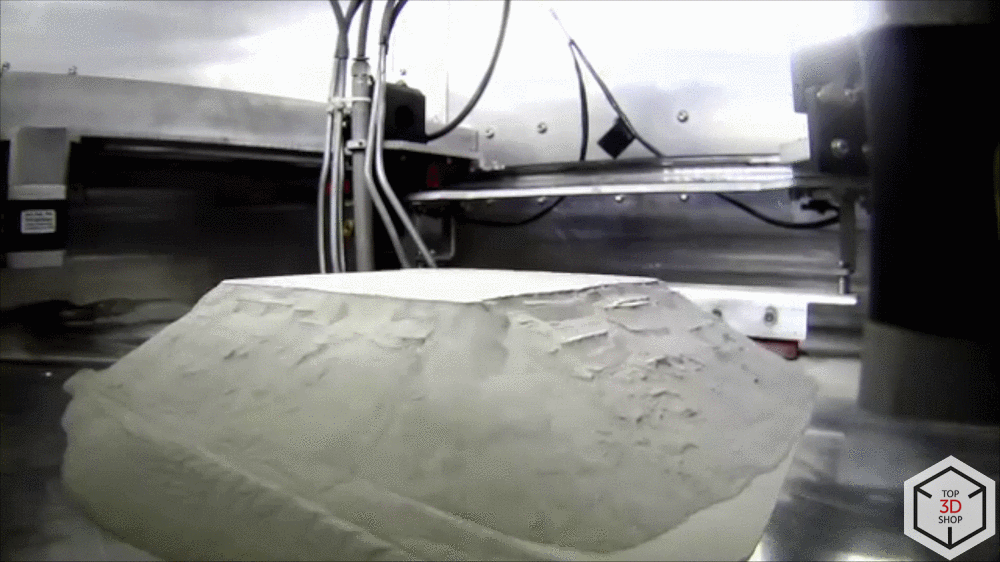Mini-review of Aurora Labs S-Titanium Pro, a metal 3D printer

Hello! This is a mini-review of Aurora Labs S-Titanium Pro - a 3D printer that prints with metal, laser fusing or sintering powder particles into a single unit.
S-Titanium Pro

Specifications
- Laser power: 300 W
- Layer thickness: 50 microns-150 microns
- Area of construction: 200x200x250 mm
- Capacity: 150 kg
- Resolution on XY: 70 microns
- Diameter of a particle: 400 microns (0,4mm)
- Resolution Z: 25 microns
- Argon consumption: 8-11 l / min
- At the first start: 25 l / min
- File format: STL / G-CODE
- Powder delivery: 3 independently controlled bunkers of 2.09 liters each
')
Requirements for the installation site:
- Space: 300x300x300 cm
- Weight (approx.): 200 kg
- Shipping weight: 350 kg
- Good ventilation: air circulation at a speed of at least 7 volumes per room

About the printer

The printer prints using DMLM (Direct Metal Laser Melting) and DMLS (Direct Metal Laser Sintering) technologies, that is, both direct laser fusion and direct laser sintering of metal.

This feature allows one device to work with such different materials as stainless steel, cobalt-chromium and aluminum-silicon-manganese alloys, bronze, titanium and its alloys, Inconel, iron and nickel-silicon-boron.
Materials
Stainless steels:
Stainless Steel 304, 309, 316L

Used in the manufacture of a wide range of parts, the main requirement for which - resistance to corrosion. They are used literally everywhere, from construction and air conditioning systems to dishes and jewelry.
Cobalt chrome:
CoCr ALEXIUM 21PM
and CoCr ALEXIUM 21PM Low C (low carbon)

Cobalt-chromium alloys are mechanically strong and resistant to acidic and alkaline media, therefore they are used for the manufacture of dental crowns.
Aluminum-silicon-manganese alloys:
AlSi7Mg and AlSi10Mg

Durable structural alloys. They are used, in particular, in the production of wheel disks, which speaks eloquently of their mechanical properties.
Bronze:
Bronze LSM Brz10

Bronze is the oldest alloy known to man: at least 4000 years BC It is used everywhere: from plumbing and jewelry, to making various statuettes and monuments, from guitar strings and furniture accessories, to the shipbuilding and aviation industries, from washers and door handles, to Olympic athletes' medals.
Titanium and its alloys:
CP Ti, Ti6Al4V

Pure (CP - commercially pure) titanium and its alloys, due to their high strength and low weight, are among the most sought-after construction materials. Titanium is approximately equal in strength to steel, with almost half the weight. It is used wherever it is economically justified, since the material is not cheap. Widely used in the construction of ships, aircraft and spacecraft. From alloys of titanium make elements of climbing equipment, lightweight and withstand heavy loads.
Inconel:
Inconel 718

Inconel is an austenitic nickel-chromium alloy with high heat resistance and high acid resistance, the combination of which exceeds tool steels. When heated, forms on the surface of a thin and durable oxide film that performs protective functions. Inconel 718 has good weldability, which is not characteristic of the entire Inconel family. It is processed by slow deep cutting with carbide tools, which makes it difficult to process with traditional, non-additive methods.
Iron:
Iron

In relatively pure form (no more than 0.8% of impurities), iron is used in electrical engineering, for the manufacture of battery components and transformers. It is widely used as an inexpensive material in cases where there is no need for long-term resistance to corrosion, as it is cheap, but reacts easily with oxygen and moisture. It can be used for the manufacture of decorative products, subject to mandatory painting or anodizing.
Boric acid nickel silicide
NiSiB (nickel-silicon-boron)

Nickel silicide is part of the heat-resistant nickel alloys, alloys with the inclusion of boron also have a high hardness. Adding this powder to the 3D printing mix will increase the hardness and heat resistance of the final product.
Print examples
Test parts were printed on Aurora Labs .

findings
Since the printer operates in two modes, DMLS and DMLM, and can print a wide range of metal powders, it seems to be the best solution for technical educational institutions and design bureaus.

Price and where to buy
Aurora Labs S-Titanium Pro in the USA costs from 55,000 dollars.
This is the best 3D printer for printing metals in its price segment.
You can buy Aurora Labs S-Titanium Pro in Russia in the Top 3D Shop : to find out the price of a printer in the Russian Federation and to pre-order, please contact us: sales@top3dshop.ru .
Looking for 3D printers and other equipment for design, production, institute or college? Write to us, the staff of Top 3D Shop will help you choose the equipment for solving any specific tasks.
Want more interesting news from the world of 3D technology?
Subscribe to us in the social. networks:




Source: https://habr.com/ru/post/421143/
All Articles